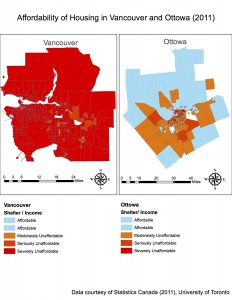HOUSING AFFORDABILITY- VANCOUVER VS OTTOWA
Affordability measures the median cost of housing by owner compared to the median household income. This is a better measure of affordability than housing cost alone because it factors in the amount of money that owners hold. This amount of money may be used as a proxy from which to infer the amount of money that household owners have available to spend on housing. If household costs alone were displayed, there is no measure of the capacity of household owner to pay for the housing costs. For instance, relatively low housing prices would not equal affordable housing if the residents of the area had little income.
The housing cost affordability rating categories range from “Affordable” with a house price to income ratio of 3.0 and under, “Moderately Unaffordable” (ratio of 3.1 to 4.0), “Seriously Unaffordable” (ratio of 4.1 to 5.0) up to “Severely Unaffordable” with a house price to income ratio of 5.0 and higher. These categories are determined by the 12th Annual Demographia International Housing Affordability Survey. This rating system is to be trusted as it uses the “Median Multiple.” This Median Multiple is widely used for evaluating urban markets, and has been “recommended by the World Bank and the United Nations and is used by the Joint Center for Housing Studies, Harvard University” (Performance Urban Planning, 2015). The Median Multiple and “other similar price-to-income multiples” are also used to analyze housing affordability by groups such as the Organization for Economic Cooperation and Development, the International Monetary Fund and The Economist (Performance Urban Planning, 2015).
While affordability may take into account the income of household owners, this measure does not factor in the price of goods and services elsewhere in the city. While property values and income may be a good indicator of livability due to the related nature of these values to livability, it is still possible that other factors such as skewed prices of goods and services (perhaps due to import or export practices) may affect livability in a way not evident simply by looking at affordability. Therefore, livability may be more coherently assessed by analyzing other variables such as prices of goods and services in addition to housing prices and household income.
Works cited:

